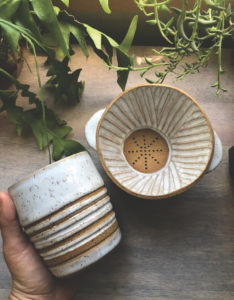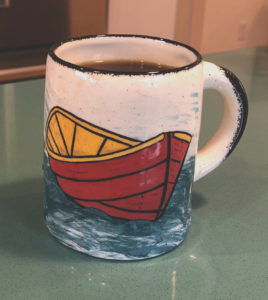Odds are, you have a favorite mug. The one at the front of your cabinet or always on your drying rack, waiting to be picked up again. It fits your hand like a glove, radiating warmth from the coffee, tea, or matcha within. Sure, sometimes you go for the novelty stein your friend gave you on your birthday, or the wonky heavy one your nephew made in his 4th-grade art class, but they never quite compare.
All of us have our own unique preferences when it comes to drinkware, but those who work in pottery may be the most particular about what makes for the best mug.
“I think what makes a good mug is the size, where the handle is situated, and how you get your hand through the handle,” says Susan Kurtzman, owner and maker of Jobi Pottery in Truro. She likes the rounded handle of Jobi’s slip-cast earthenware mugs for its comfort and solid durability.
“I always like stacking mugs,” says Isabel Souza, another potter from Truro. The efficient use of space is something she has in mind when creating her hand-thrown vessels. Souza also notes that she likes mugs that keep her coffee hot longer. Short mugs with wide openings don’t keep liquids hot for as long, so smaller, more enclosed shapes are, for her, the way to go.
Handles are a non-issue, you might say, for Heather LaFortune, a recently transplanted local maker, whose handle-less mug is among the picks of the tea specialists at the Captain’s Daughters in Provincetown. Unencumbered by a handle, her favorite mug is one that “can sit in your cup holder — a to-go cup that’s reusable,” she says. She pairs hers with a lid that fits snugly on top, keeping the contents from spilling.
A few other features that can make a mug a favorite: the thickness of the lip for Kurtzman, the weight of the entire piece for Souza, and the quality of the natural unglazed clay body for LaFortune.
The lip of the vessel should be smooth and thin enough to make the cup easy to sip from, but not so thin that it becomes fragile. The mug should also be of comfortable weight, according to Souza, as a heavy mug can be distracting. For LaFortune, texture is key — while some unglazed clay can have a satisfying, sandy texture, she says, it’s not pleasing to hold a rough or abrasive mug.
It turns out that any of these qualities can determine the difference between an ordinary cup and the perfect mug.
“I had a teacher one time who said, ‘What other object is as intimate as a mug?’ ” says Souza.
When you find your perfect mug, you just know.






